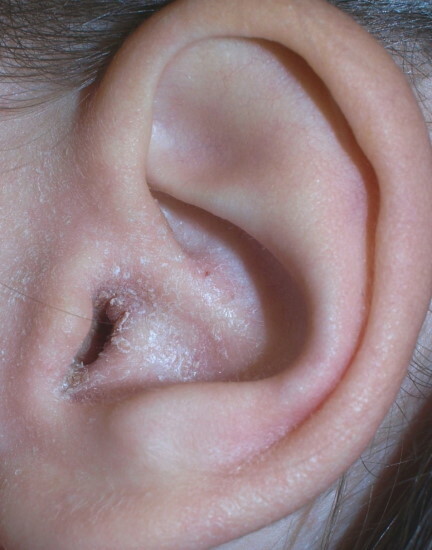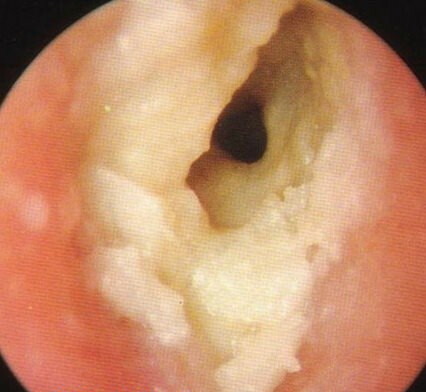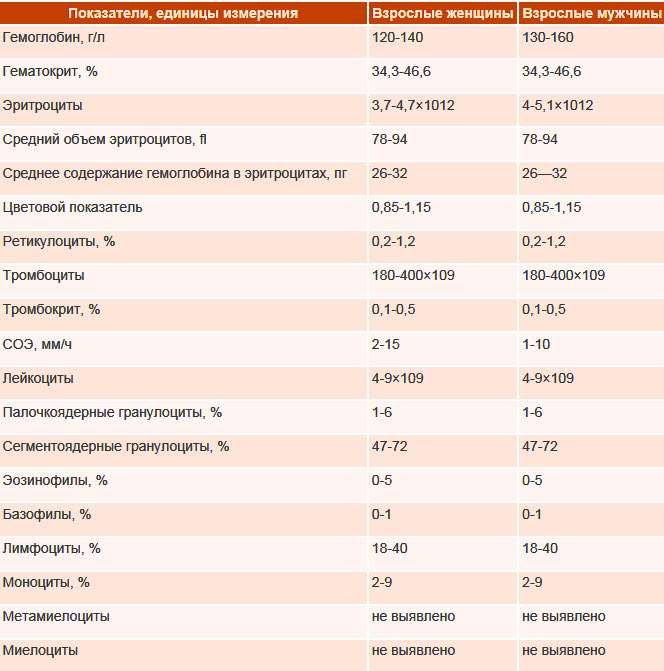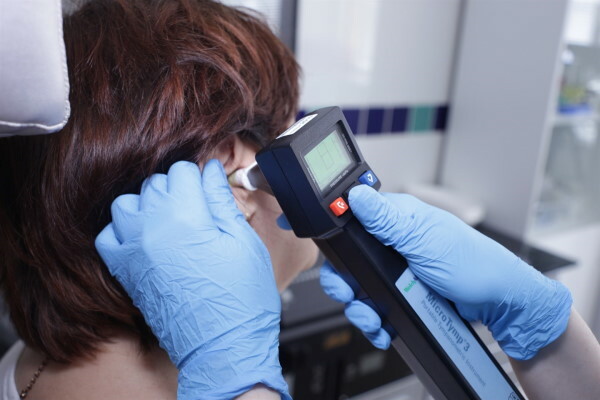Content
- Causes of the appearance of white plaque in the ears and behind them
- Determination of the cause by additional features
- With the defeat of the ear sebaceous glands
- With seborrhea
- Otomycosis
- Diagnostics
- Laboratory diagnostics
- Instrumental diagnostics
- Differential diagnosis
- How to get rid of white flakes
- Local drug treatment
- Systemic drug treatment
- ethnoscience
- Possible consequences in the absence of therapy
- Video about white plaque in the ears
White bloom forms in the outer ear and is a sign of various diseases. Pathology often occurs in children and requires mandatory therapy. If left untreated, the disorder can worsen and lead to severe complications.
Causes of the appearance of white plaque in the ears and behind them
There are many provoking factors due to which pathology develops. This symptom can arise as a result of external influences. The same is due to other internal violations.
Causes:
- lack or insufficient hygiene procedures (ear care);
- improper diet (lack of nutrients and vitamins);
- hormonal disorders (especially in adolescents or during pregnancy);
- long-term wearing of a hearing aid;
- impaired metabolism;
- ear injuries;
- abuse of ear drops;
- occupational diseases (in swimmers);
- consequences caused by previous otitis media or other ear diseases;
- prolonged stay in rooms with high or low humidity;
- diabetes;
- diseases of the liver and gastrointestinal tract.
Most often, pathology develops against the background of infection with fungal pathogens. Thus, the main cause of dandruff in the ears is otomycosis.
Determination of the cause by additional features
It is possible to determine the cause of the violation by the characteristic signs that are inherent in a particular disease.
With the defeat of the ear sebaceous glands
The defeat of the sebaceous glands is accompanied by the development of inflammatory reactions. In this case, purulent exudates are formed in one or more cavities.
Clinical picture:
- ear congestion;
- pain syndrome;
- the development of hearing loss;
- noise in ears;
- dizziness;
- runny nose;
- increased body temperature;
- an increase in the size of the lymph nodes located near the ears.
Discharge of a different nature can also form - bloody, transparent or purulent.
With seborrhea
White plaque in the ears can occur as a result of the development of seborrheic dermatitis, regardless of where it occurs. Pathology has its own clinical picture, which is different from other diseases.
Symptoms:
- itchy elements (in the area of the ear canal and directly on the ear itself);
- inflammation of the skin around the affected area;
- hyperemia;
- increased pigmentation;
- swelling;
- the formation of nodules filled with sulfur.
When the bubbles are opened, pain and discomfort occur.
Otomycosis
With otomycosis, in addition to white plaque, the formation of liquid secretions is observed. In this case, the condition is accompanied by pain syndrome. In some cases, the violation is acute. The intensity of the pain increases during swallowing.
By the nature of the discharge, the specialist can suggest the causative agent that led to the development of the disease.
Other signs:
- ear congestion;
- decreased acuity of auditory perception;
- dizziness;
- burning and itching;
- violations in the vestibular apparatus;
- hyperemia;
- swelling;
- peeling of the skin;
- perforation of the tympanic membrane.

The presence of a gray plug with liquid discharge indicates a lesion of the auricle aspergillus. Discharge with a greenish or yellowish tinge indicates infection with penicilli. A white, curdled discharge may indicate the presence of candida.
Diagnostics
To establish the cause and choose a treatment regimen, it is necessary to undergo a comprehensive study. First of all, a visual examination of the auricle is carried out, the nature of the plaque is determined, and the presence of discharge is established.
To confirm the diagnosis, the patient is sent for additional examinations.
Laboratory diagnostics
Laboratory research methods make it possible to identify the nature of the origin of the pathology, the degree of damage and the causative agent that led to the development of the disease.
| Research type | What determines |
| General urine test | Allows you to detect colonies of fungal bacteria in the urine. At the same time, other indicators remain within the normal range. |
| General blood test | Diagnostics helps to identify inflammatory processes in the body. An analysis is prescribed even in the absence of inflammation.
|
| Cultural research (bacterial sowing) | For diagnosis, a scraping is taken from the affected area, which is then sown in special nutrient media. The growth of colonies is studied, on the basis of which a diagnosis is made and the most suitable and effective therapy is selected |
| Microscopic examination | It is carried out to study the secretions. During the procedure, native preparations or products with staining can be used. When the diagnosis is confirmed, the presence of spores or micelles is observed |
In the case of the spread of pathology or its development against the background of other disorders, the patient is sent to consultation with other narrow-profile specialists who may prescribe additional laboratory research.
Instrumental diagnostics
White plaque in the ears requires a whole range of instrumental methods, since the disease can occur against the background of other disorders and lead to the development of complications.
Instrumental diagnostics allows you to determine the presence of concomitant diseases and assess the degree of involvement of neighboring organs and systems. First of all, the doctor examines the presence of infections, foreign bodies, or injuries in the ear canal. For this, a special device (otoscope) is used. The technique is non-invasive and completely painless.
Other methods (used if there are appropriate symptoms):
- Tympanometry - determination of the functions of the auditory tube and the degree of mobility of the bones in the middle ear.

- Audiometry is a test of the acuity of auditory perception. Runs on your computer.
- Radiography - diagnostics allows you to detect focal inflammatory processes.
- Ultrasound - the structure of the ear is studied, the presence of damage and the degree of inflammation are determined.
- Tomography - carried out with the help of a computer, helps in the presence of foreign bodies or neoplasms.
As a rule, these studies are sufficient to establish the violation and make an accurate diagnosis.
Differential diagnosis
Differential diagnosis allows you to establish the exact cause of the disorder and separate it from other ear diseases. An incorrect diagnosis leads to the appointment of ineffective therapy and the possible development of complications.
To determine the cause, laboratory studies of the secretions are carried out and samples of biological material are taken, which makes it possible to identify the pathogen. In most cases, the violation is caused by yeast-like fungi. For infections and ear infections, most antifungals are not effective.
In some cases, plaque can occur with seborrheic lesions of the head or as a result of a prolonged respiratory infection. Anti-cold drugs will also not affect the pathology and will help to eliminate only some of the symptoms (pain, inflammation). Differential diagnosis is mandatory, especially if the disorder develops in children.
How to get rid of white flakes
White bloom with flakes can occur for various reasons, having determined which, you can select the appropriate therapy. At the same time, local preparations intended for external treatment of the affected areas of the ears are recommended to be used in combination with systemic agents.
Local drug treatment
There are many different products on the pharmaceutical market for topical treatment of affected areas. Similar drugs are selected on an individual basis, based on the pathogen and other characteristics of the disease.
Preparations:
- Tar medicines (Friderm, Sebuton) - have an antimicrobial effect, help to eliminate the stratum corneum and stimulate the growth of new cells.
- Medicines with zinc (Friedemr zinc, Prithion zinc, Octopirox, salicylic acid) - have antimicrobial and antifungal effects.
- Preparations (ointments) with antifungal action - Ketoconazole, Nizoral, Clotrimazole.
- Anti-inflammatory and antimycotic agents - Quassia Amara (cream for external use).
- Antibiotics - Otipax, Otofa (drops). Prescribed in case of bacterial infection.
- Means (creams) with antifungal action - Sulsena, Lamisil, Exoderil.
Various shampoos can also be prescribed that prevent the further development of the fungus - Sulsen, Sebazol, Algopix, Elfa, Keto plus.
The rules of application and the duration of the course are set by the attending physician individually, taking into account the severity of the disorder, the age of the patient and other features of the physiology and course of the disease.
Systemic drug treatment
Systemic drugs are selected according to the microorganism (fungus) identified during the research. First of all, drugs with antifungal action are prescribed (Amphoterecin, Fluconazole, Itramikol).
With the development of inflammatory reactions and otitis media, antibacterial agents are recommended. In case of allergic reactions, non-steroidal anti-inflammatory drugs (NSAIDs) and antihistamines (Zodak, Claritin, Tavegil) can be prescribed.
As a supplement, various medications are used to help restore the intestinal microflora (Linex, Acipol), as well as various mineral and vitamin complexes (Alphabet, Aevit).
ethnoscience
White plaque in the ears must be treated in a complex way using various means recommended by a specialist. Traditional medicine can only be used as an auxiliary therapy, since they are not able to cope with the disease on their own.
Treatment methods:
- Sunflower oil. Can be used in conjunction with turunda. To do this, twist the cotton wool into a roll and moisten it in slightly heated oil. The resulting turunda must be carefully inserted into the ear canal for 15 minutes. Then rub the ear with a dry cloth. You can use this method 2-3 times a day. The duration of the course is 10-14 days.
-
Healing infusion of chamomile. You need to take 1-2 tbsp. dry flowers and pour them 0.2 liters of boiling water. The mixture should be infused for 20 minutes. in the infusion, cotton wool is moistened and applied to the peeling sites.

- Novocaine. It is necessary to moisten a cotton swab in the solution and wipe the problem areas. Use several times a day. The duration of therapy is 1.5-2 months.
- Garlic mixture. To prepare it, you need to crush the garlic and add a few drops of sunflower or olive oil to it. Insist for 15-20 minutes. and wipe down problem areas.
- Exfoliating mask. You will need rye bread, crushed to a state of gruel, and a few tablespoons of boiled water. Mix everything, allow to cool and apply to the peeling areas. Apply as needed in small courses.
You can achieve the elimination of the disease with the help of various oils - rose hips, roses, calendula or sea buckthorn. These funds are used in diluted form (together with emulsifiers).
It should be borne in mind that after using folk methods, the auricles and the ear itself must not be treated with alcohol. In this case, the remnants of the funds are washed off under running water without adding soap or other cosmetic funds, since this can lead to a deterioration in the condition and provoke the development of allergic reactions.
Before using alternative methods of treatment, it is recommended to first consult with a specialist.
Possible consequences in the absence of therapy
In the absence of timely therapy, pathology can flow into a chronic form and cause various complications.
Effects:
- the formation of adhesions;
- the appearance of scar tissue in the area of the tympanic membrane;
- decreased hearing acuity;
- defeat by fungal infections of neighboring ENT organs;
- perforation of the tympanic membrane;
- suppuration and secondary infection;
- damage to the auditory nerve;
- fungal infection of the bones of the skull;
- hearing loss.
If a white plaque forms in one or both ears at once, you should immediately consult a specialist. A timely diagnosis and adequate therapy will help to avoid dangerous complications and prevent further development of the disease.
Video about white plaque in the ears
Malysheva about the fungus in the ears:


